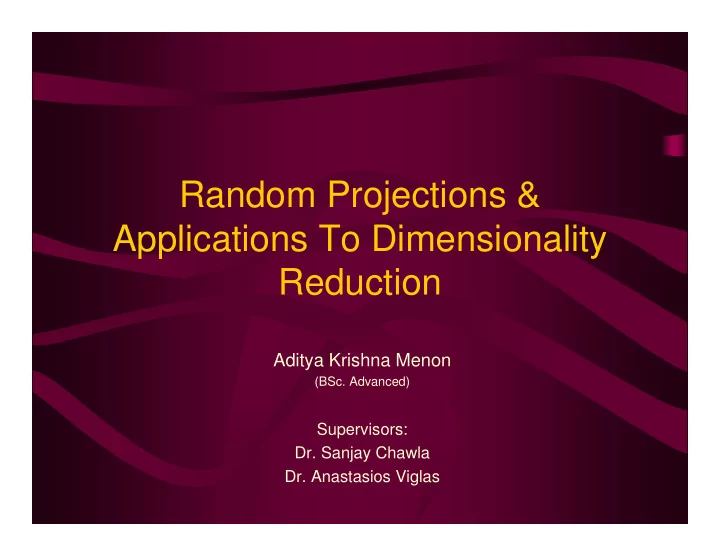

Random Projections & Applications To Dimensionality Reduction Aditya Krishna Menon (BSc. Advanced) Supervisors: Dr. Sanjay Chawla Dr. Anastasios Viglas
High-dimensionality • Lots of data → objects/items with some attributes – i.e. high-dimensional points – ⇒ Matrix • Problem: number of dimensions usually quite large – Data analysis usually sensitive to this • e.g. Learning, clustering, searching, … – ⇒ Analysis can become very expensive • The ‘curse of dimensionality’ – Add more attributes ⇒ exponentially more time to analyze data
Solution? • Reduce dimensions, but keep structure – i.e. map original data → lower dimensional space – Aim: do not distort original too much – ‘Dimensionality reduction’ • Easier to solve problems in new space – Not much distortion ⇒ can relate solution to original space
Random projections • Recent approach: random projections • Idea: project data onto random lower dimensional space – Key: most distances (approx.) preserved – Matrix multiplication
Illustration Original n points in New n points in A.R d dimensions k dimensions A E n x d n x k R is some ‘special’ random matrix e.g. Gaussian Guarantee : With high probability, distances between points in E will be very close to distances between points in A [Johnson and Lindenstrauss]
Aims of my project • Can we solve data-streaming problems efficiently, and accurately, using projections? • Can we improve existing theory on ‘interesting’ properties random projections? – Preservation of dot-products – Guarantees on the reduced dimension
My contributions • Application of projections to data streaming • Novel result on preservation of dot-product • Theoretical results on lowest dimension bounds
I: Streaming scenario • Scenario: have a series of high-dimensional streams, updated asynchronously – i.e. Arbitrarily updated • Want to query on distance / dot-product between streams – e.g. To cluster the streams at fixed point in time • Problem: might be infeasible to instantiate the data – Or might be too expensive to work with high-dimensions • Usual approach is to keep a sketch – Small space – Fast, accurate queries • Aim: can we use projections to maintain a sketch? – Comparison to existing sketches?
My work on streams • Showed we can efficiently use projections to keep sketch – Can quickly make incremental updates to sketch • As if you did a projection each time! – Guarantee: preserves Euclidean distances among streams • Generalization of [Indyk] – Related to a special case of a random projection • Comparison – As accurate than [Indyk] – Faster than [Indyk] • 2/3rds sparse matrix [Achlioptas]
Experiments • Use projections to allow k -means clustering of high-dimensional ( d = 10 4 ) streams • Results – At least as accurate than [Indyk] – Marginally quicker
II: Dot-product • Dot-product is quite a useful quantity – e.g. For cosine similarity • On average, projections preserve dot-products – But typically large variance – Not an easy problem • “Inner product estimation is a difficult problem in the communication complexity setting captured by the small space constraint of the data stream model” [Muthukrishnan] • Question: can we derive bounds on the error?
My work on dot-products • Result: derived new bound on error incurred in dot-product after random projection – High-probability upper bound on the error – Complements existing work on dot-product preservation • My bound based on distance error and lengths of vectors • Existing results based on reduced dimension and lengths of vectors
III: Lowest dimension bounds • Projections give bounds on reduced dimension – ‘If I want 10% error in my distances, what is the lowest dimension I can project to’? • [Achlioptas]’ bounds are most popular – But quite conservative [Lin and Gunopulos] • Aim: try to improve results on bounds for reduced dimension – Look at when bound is not meaningful – Better special cases?
My work on bounds • Results: – Theorem on analysis of applicability of [Achlioptas]’ bound • NASC conditions for it to be ‘meaningless’ – Points exponential in number of dimensions – Stronger result for data from Gaussian distribution • Error restriction
Conclusion and future work • Random projections are an exciting new technique – Applications to dimensionality reduction and algorithms – Worthwhile studying properties • My contributions – Proposed application to data-streams – Novel result on preservation of dot-product – Improved theoretical analysis on bounds • Future work – [Li et. al]’s matrix and data-streams – Lower bound analysis – Guarantees for projections in other problems e.g. circuit fault diagnosis
References • [Achlioptas] Dimitris Achlioptas. 2001. Database-friendly random projections. In PODS ’01: Proceedings of the Twentieth ACM SIGMOD-SIGACT-SIGART Symposium on Principles of Database Systems , pages 274–281, New York, NY, USA. ACM Press. • [Indyk] Piotr Indyk. 2006. Stable distributions, pseudorandom generators, embeddings, and data stream computation. J. ACM , 53(3):307–323. • [Johnson and Lindenstrauss] W.B. Johnson and J. Lindenstrauss. 1984. Extensions of Lipschitz mappings into a Hilbert space. In Conference in Modern Analysis and Probability , pages 189–206, Providence, RI, USA. American Mathematical Society
References • [Li et al.] Ping Li, Trevor J. Hastie, and Kenneth W. Church. 2006. Very sparse random projections. In KDD ’06: Proceedings of the 12th ACM SIGKDD international conference on Knowledge discovery and data mining, pages 287–296, New York, NY, USA. ACM Press. • [Lin and Gunopulos] Jessica Lin and Dimitrios Gunopulos. 2003. Dimensionality reduction by random projection and latent semantic indexing. Unpublished. In Proceedings Of The Text Mining Workshop at the 3 rd International SIAM Conference On Data Mining. • [Muthukrishnan] Data Streams: Algorithms And Applications . Now Publishers, 2005.
Recommend
More recommend